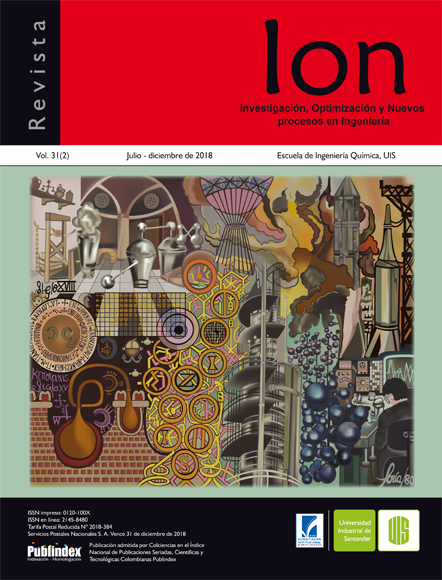Published 2019-01-16
Keywords
- hemicellulose,
- pyrolysis,
- ferric sulfate,
- zinc sulfate,
- catalysis
How to Cite
Abstract
Using the thermogravimetric analysis technique, the catalytic effect of ferric sulfate and zinc sulfate on the pyrolysis of hemicellulose was studied. Thermograms of the pyrolysis of pure hemicellulose and hemicellulose mixed with 3 % of catalysts were obtained at heating rates of 10, 30, and 100 K/min. The effect of heating rate and catalysts on the shape of thermograms, DTG peak temperature of weight loss events, and kinetics parameters was evaluated. Results were fitted to three kinetic models. The presence of these salts strongly change the thermogram forms and DTG temperature peaks with respect to the corresponding pure hemicellulose thermograms. Data from the three systems studied were well-modeled by the distributed activation energy model, DAEM. By comparing these and the respective results of the decomposition model proposed in the literature, it is possible to infer that the sulphates under study catalyze the reactions of dehydration/fragmentation and de-polymerization of hemicellulose.
Downloads
References
[2] Sonobe T, Worasuwannarak N. Kinetic analyses of biomass pyrolysis using the distributed activation energy model. Fuel. 2008;87(3):414-21.
[3] Wang S, Guo X, Wang K, Luo Z. Influence of the interaction of components on the pyrolysis behavior of biomass. J. Anal. Appl. Pyrolysis. 2011;91(1):183-9.
[4] Worasuwannarak N, Sonobe T, Tanthapanichakoon W. Pyrolysis behaviors of rice straw, rice husk, and corncob by TG-MS technique. J. Anal. Appl. Pyrolysis. 2007;78(2):265-71.
[5] Granada E, Eguía P, Comesaña J, Patiño D, Porteiro J, Miguez J. Devolatilization behaviour and pyrolysis kinetic modelling of Spanish biomass fuels. J. Therm. Anal. Calorim. 2013;113(2):569-78.
[6] Gani A, Naruse I. Effect of cellulose and lignin content on pyrolysis and combustion characteristics for several types of biomass. Renew. Energy. 2007;32(4):649-61.
[7] Yang H, Yan R, Chen H, Lee DH ,Zheng C. Characteristics of hemicellulose, cellulose and lignin pyrolysis. Fuel. 2007;86(12):1781-8.
[8] Lv D, Xu M, Liu X, Zhan Z, Li Z, Yao H. Effect of cellulose, lignin, alkali and alkaline earth metallic species on biomass pyrolysis and gasification. Fuel Process. Technol. 2010;91(8):903-9.
[9] Khelfa A, Bensakhria A, Weber J. Investigations into the pyrolytic behaviour of birch wood and its main components: primary degradation mechanisms, additivity and metallic salt effects. J. Anal. Appl. Pyrolysis. 2013;101:111-21.
[10] Zhang H, Xiao R, Jin B, Xiao G, Chen R. Biomass catalytic pyrolysis to produce olefins and aromatics with a physically mixed catalyst. Bioresour. Technol. 2013;140:256-62.
[11] Richards GN, Zheng G. Influence of metal ions and of salts on products from pyrolysis of wood: applications to thermochemical processing of newsprint and biomass. J. Anal. Appl. Pyrolysis. 1991;21(1-2):133-46.
[12] Dobele G, Rossinskaja G, Dizhbite T, Telysheva G, Meier D, Faix O. Application of catalysts for obtaining 1, 6-anhydrosaccharides from cellulose and wood by fast pyrolysis. J. Anal. Appl. Pyrolysis. 2005;74(1):401-05.
[13] Albis A, Ortiz E, Suárez A, Piñeres I. TG/MS study of the thermal devolatization of Copoazú peels (Theobroma grandiflorum). J. Therm. Anal. Calorim. 2014;115(1):275-83.
[14] Martín-Lara M, Blázquez G, Zamora M, Calero M. Kinetic modelling of torrefaction of olive tree pruning. Appl. Therm. Eng. 2017;113:1410-8.
[15] Açıkalın K. Pyrolytic characteristics and kinetics of pistachio shell by thermogravimetric analysis. J. Therm. Anal. Calorim. 2011;109(1):227-35.
[16] Abdelouahed L, Leveneur S, Vernieres-Hassimi L, Balland L, Taouk B. Comparative investigation for the determination of kinetic parameters for biomass pyrolysis by thermogravimetric analysis. J. Therm. Anal. Calorim. 2017:1-13.
[17] Chen N, Ren J, Ye Z, Xu Q, Liu J, Sun S. Kinetics of coffee industrial residue pyrolysis using distributed activation energy model and components separation of bio-oil by sequencing temperature-raising pyrolysis. Bioresour. Technol. 2016;221:534-40.
[18] Cheng Z, Wu W, Ji P, Zhou X, Liu R, Cai J. Applicability of Fraser–Suzuki function in kinetic analysis of DAEM processes and lignocellulosic biomass pyrolysis processes. J. Therm. Anal. Calorim. 2015;119(2):1429-38.
[19] Donskoi E, McElwain D. Optimization of coal pyrolysis modeling. Combustion and Flame. 2000;122(3):359-67.
[20] Janković B. The pyrolysis process of wood biomass samples under isothermal experimental conditions—energy density considerations: application of the distributed apparent activation energy model with a mixture of distribution functions. Cellulose. 2014;21(4):2285-314.
[21] Várhegyi G. Aims and methods in non-isothermal reaction kinetics. J. Anal. Appl. Pyrolysis. 2007;79(1):278-88.
[22] Várhegyi G, Szabó P, Antal MJ. Kinetics of charcoal devolatilization. Energy & fuels. 2002;16(3):724-31.
[23] Collard F-X, Blin J. A review on pyrolysis of biomass constituents: Mechanisms and composition of the products obtained from the conversion of cellulose, hemicelluloses and lignin. Renew. Sustain. Energy Rev. 2014;38:594-608.
[24] Dorez G, Ferry L, Sonnier R, Taguet A, Lopez-Cuesta J-M. Effect of cellulose, hemicellulose and lignin contents on pyrolysis and combustion of natural fibers. J. Anal. Appl. Pyrolysis. 2014;107:323-31.
[25] Zhou X, Li W, Mabon R, Broadbelt LJ. A critical review on hemicellulose pyrolysis. Energy Technology. 2017;5(1):52-79.
[26] Williams PT, Horne PA. The role of metal salts in the pyrolysis of biomass. Renew. Energy. 1994;4(1):1-13.
[27] Jakab E. Analytical techniques as a tool to understand the reaction mechanism. En: Recent advances in thermo-chemical conversion of biomass. EEUU: Elsevier; 2015. p. 75-108.
[28] Saddawi A, Jones J, Williams A, Wojtowicz M. Kinetics of the thermal decomposition of biomass. Energy & fuels. 2009;24(2):1274-82.
[29] Zhang J, Chen T, Wu J, Wu J. Multi-Gaussian-DAEM-reaction model for thermal decompositions of cellulose, hemicellulose and lignin: comparison of N 2 and CO 2 atmosphere. Bioresour. Technol. 2014;166:87-95.
[30] White JE, Catallo WJ, Legendre BL. Biomass pyrolysis kinetics: a comparative critical review with relevant agricultural residue case studies. J. Anal. Appl. Pyrolysis. 2011;91(1):1-33.

